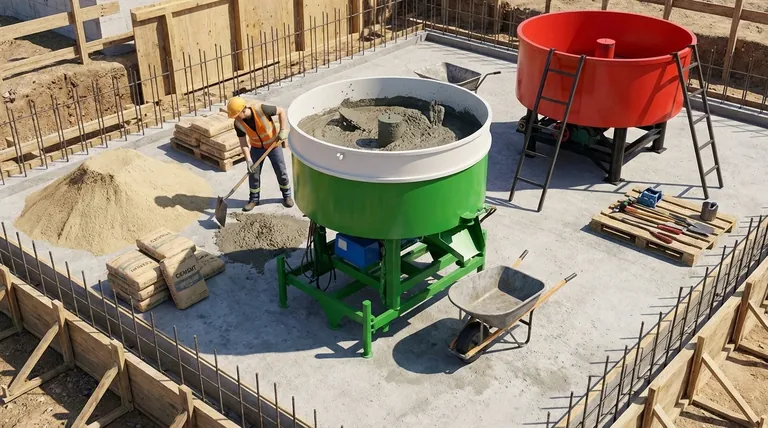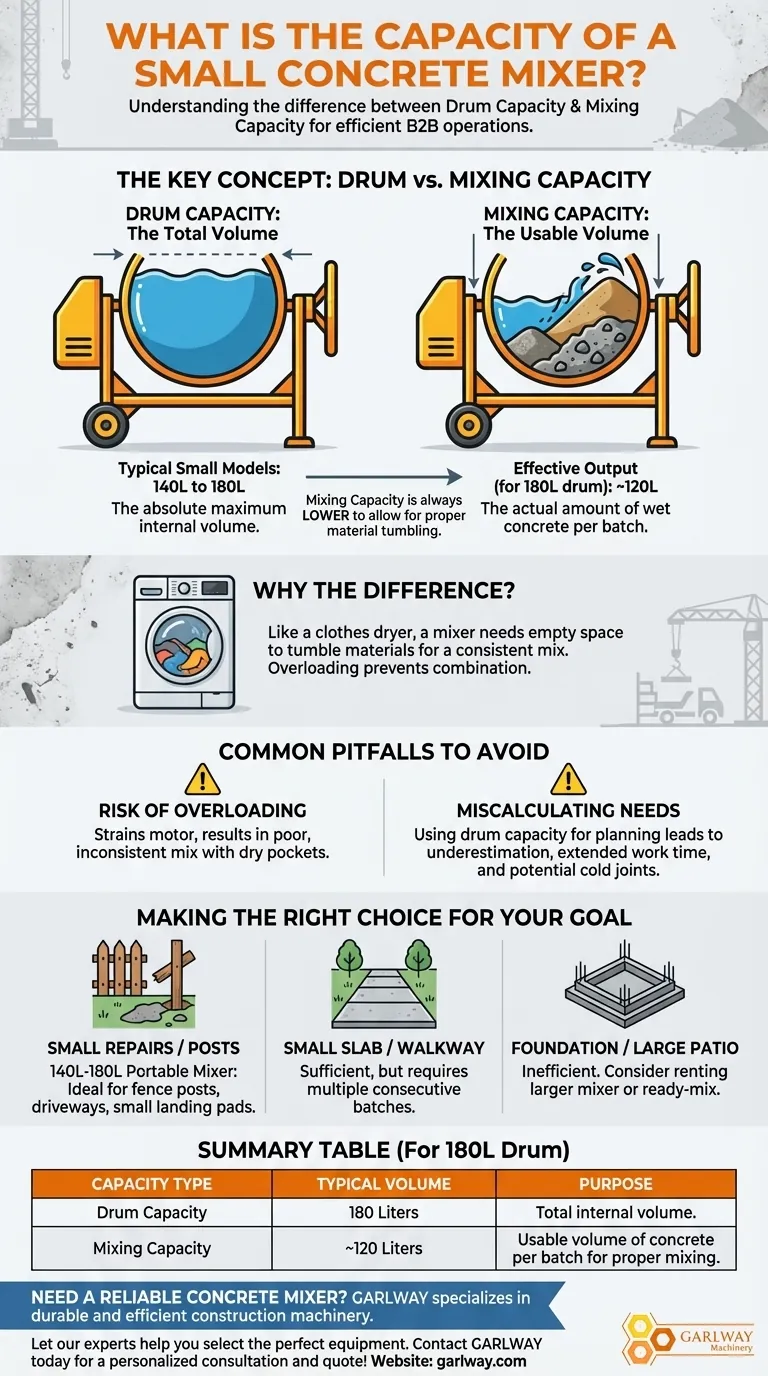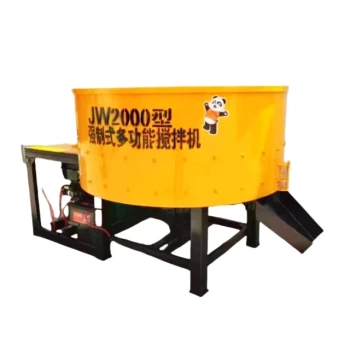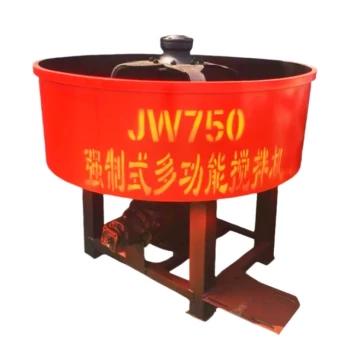To be direct, a typical small, portable concrete mixer has a maximum drum capacity of around 140 to 180 liters (approximately 5 to 6 cubic feet). However, the crucial figure for your work is the mixing capacity, which is significantly lower, usually around 120 liters (or 4 cubic feet) for a 180L drum.
The most critical concept to understand is the difference between a mixer's drum capacity (the total volume of the drum) and its mixing capacity (the actual amount of concrete it can effectively produce per batch). The mixing capacity is always lower to allow for proper material tumbling.

Understanding Mixer Capacity Metrics
When you see a capacity listed for a small mixer, it's essential to know which number you're looking at. Manufacturers often advertise the larger drum capacity, but the mixing capacity is what determines your workflow and output.
Drum Capacity: The Total Volume
Drum capacity is the total internal volume of the mixer's drum if you were to fill it to the brim. For common portable models, this is often advertised as 140L or 180L.
This number represents the absolute maximum space inside the machine.
Mixing Capacity: The Usable Volume
Mixing capacity is the practical, recommended volume of wet concrete that the mixer can produce in a single batch. For a 180L mixer, the effective mixing capacity is typically around 120L.
This is the number that dictates how much concrete you can pour at one time. A mixer is designed to operate at an angle, and it needs empty space for the ingredients—cement, sand, aggregate, and water—to cascade and combine thoroughly.
Why Are They Different?
The difference is purely functional. Think of it like a clothes dryer; you can't fill it completely and expect your clothes to dry evenly. They need space to tumble.
A concrete mixer works on the same principle. Overloading it past its mixing capacity prevents the materials from combining, resulting in a weak, inconsistent, and unusable batch of concrete.
Common Pitfalls to Avoid
Understanding capacity isn't just about the numbers; it's about preventing common mistakes that can waste time and materials on a job site.
The Risk of Overloading
The most frequent error is attempting to mix a batch that is too large for the machine. This puts excessive strain on the motor and leads to poorly mixed concrete with dry pockets or clumps.
Always adhere to the manufacturer's recommended mixing capacity, not the drum capacity.
Miscalculating Project Needs
Failing to distinguish between the two capacity ratings can cause you to underestimate the number of batches required for your project. This extends your work time and can be a serious issue when pouring a slab that needs to be finished before it sets.
Always base your calculations on the smaller mixing capacity figure to plan your work accurately.
Making the Right Choice for Your Goal
The capacity of a small mixer is specifically suited for certain types of jobs. Use your project goal to determine if it's the right tool.
- If your primary focus is small repairs or post-setting: A standard 140L-180L portable mixer is ideal for tasks like setting fence posts, patching driveways, or pouring a small landing pad.
- If your primary focus is a small slab or walkway: This size is sufficient, but be prepared to mix multiple batches consecutively to ensure a consistent pour without creating cold joints.
- If your primary focus is a foundation or large patio: A small portable mixer is inefficient for this scale; you should consider renting a larger mixer or ordering ready-mix concrete.
Ultimately, understanding a mixer's true usable capacity empowers you to work efficiently and produce strong, reliable concrete.
Summary Table:
| Capacity Type | Typical Volume (for a 180L Drum) | Purpose |
|---|---|---|
| Drum Capacity | 180 Liters | Total internal volume of the drum. |
| Mixing Capacity | ~120 Liters | Usable volume of concrete per batch for proper mixing. |
Need a reliable concrete mixer for your next project?
Choosing the right mixer capacity is crucial for efficiency and quality. GARLWAY specializes in construction machinery, offering durable and efficient concrete mixers, winches, and batching plants designed for the needs of construction companies and contractors globally.
Let our experts help you select the perfect equipment to meet your project's demands and ensure a strong, consistent pour every time.
Contact GARLWAY today for a personalized consultation and quote!
Visual Guide

Related Products
- Auto Concrete Cement Mixer Machine New
- Commercial Construction Mixer Machine for Soil Cement Mixing Concrete
- Construction Products Concrete Plant Machine Mixing Concrete Mixer
- JDC350 Small Cement Concrete Mortar Mixer
- HZS90 Large Multiquip Concrete Mixers for Construction
People Also Ask
- How to choose the right concrete mix? A Guide to Balancing Strength, Workability, and Cost
- How do I choose a cement mixer? Find the Perfect Match for Your Project Scale and Power Needs
- How long does it take to mix concrete in a portable mixer? Master the 60-Minute Rule
- Can you mix self leveling concrete in a cement mixer? Avoid Costly Flooring Mistakes
- What are the 4 classifications of concrete mix? Choose the Right Mix for Your Project's Success



















